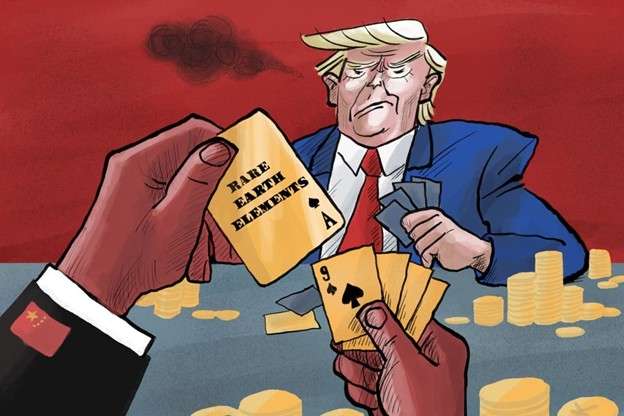
25 Oct China’s “Trump Card”
“China’s advantages in the production and refinement of rare earth elements are significant.” – The Lonely Realist
TLR this week received a number of emails disagreeing with TLR‘s assertion in last week’s commentary that China’s virtual monopoly over rare earth elements – that is, its 70% share of global production and 90% share of global refining – gives China the economic advantage over America. Some readers noted that China is dependent on importing American foodstuffs and would be unable to leverage its REE dominance without seriously depriving its populace. Others focused on the perceived success of the Trump Administration’s actions to onshore both REE production and REE refining. The fact is that China can import adequate foodstuffs (and is doing so from Brazil, Argentina, Indonesia, etc.), the Chinese populace – and its authoritarian Communist Party leaders – can tolerate pain far more readily than would America’s voters the American public (evidenced in part by the reaction of America’s soyabean farmers to China’s embrace of Brazilian soyabeans), and America’s efforts to upgrade REE mining, production and refining will take years to implement, even with the assistance of Australia.
This crisis – and, yes, it is a crisis –, was entirely foreseeable and entirely avoidable by each of Presidents Clinton, Bush2, Obama, Trump 1.0, and Biden. China made no secret of its plan to weaponize REEs. As early as 1992, Deng Xiaoping, China’s leader, explicitly stated China’s intent to exploit its leverage with respect to rare earth elements, noting that “The Middle East has oil, China has rare earths.” For the next 3 decades, America was complicit. In 1995, the Committee on Foreign Investment in the U.S. (CFIUS) approved the sale to Chinese owners of Magnequench, an American manufacturer of rare earth magnets used in computers and jet guidance systems. CFIUS’ approval was based in part on the buyer’s promise to keep the factory in America. It didn’t. It shut down operations after a few years and moved the equipment to China. The Bush2 Administration was aware of China’s bid to monopolize the REE market and took no countermeasures even though the U.S.-China Economic and Security Review Commission in 2005 reported that closure of the Magnequench facility “allowed China to come closer to cornering the market in rare earth minerals.” Using its state control over low-cost REE production and extraction, China thereafter brought/bought the majority of the world’s critical minerals industry under its domination (employing the tried-and-true economic pressure strategy it has used to dominate other industries (e.g., shipping)). China has played its REE “trump card” perfectly…, and today has effective control over the global supply of REEs.
Trump 2.0 nevertheless has launched an economic offensive against China, imposing tariffs and limiting U.S. technology transfers in an effort to starve China of cutting-edge technology and intellectual property. In addition, President Trump is threatening ever-broader tariffs and sanctions. In response to these actual and threatened economic attacks, China proactively put in place mechanisms designed to starve America (and other countries that oppose its policies) of critical raw materials (and also to restrict America’s trading advantages). This is the conflict about which TLR repeatedly has warned. With China and America in an ongoing war for global dominance, President Trump now has escalated the conflict in the belief that America has the superior economic weaponry. Although the U.S.-China war is not yet “hot,” he has warmed it up. Ray Dalio (among others) notes that America and China are engaged in a technology battle that neither can afford to lose. Does China’s monopoly over REEs give it the edge? Or does America continue to have economic superiority?
China’s REE dominance already has paid it dividends. Witness President Trump’s concessions on ownership and control of TikTok and his TACO retreats (labeled “delays”) from proposed tariff increases. But it is not only these goals that China seeks. It is also employing its REE leverage to further access American technology and to pressure America to allow it (in due course) to absorb Taiwan (the latter being Party Leader Xi’s highest priority). Trump 2.0’s “America First” agenda is not opposed to either goal. The U.S. no longer views alliances as sacrosanct. That includes its alliance with Taiwan. In fact, Trump 2.0 is seeking to preemptively move Taiwan’s chip manufacturing capabilities to America. America’s economic nationalism means that past decades of just-in-time global economic and geopolitical integration (“globalization”) are over. America is building protectionist walls, both physically (on America’s southern border) and in practical business and military terms, in an effort to eliminate American dependency on, and involvement with, other countries. The goal is for the U.S. to produce everything of importance internally in an insular “America First” economy…, if that is at all possible. President Trump also has made it clear that he is disinclined to will not involve America in foreign wars – which would include defending Taiwan – and that America will protect itself without the support of (and without giving potentially risky military support to) its former allies. Whether or not these goals are possible, it is in China’s interest to use REE leverage to incentivize America to pursue them.
The critical aspect for American success in an economic war with China is, of course, internal progress in rebuilding U.S. infrastructure though investment in research, support for critical industries, and attracting global talent. Yet the Trump Administration has cut, and is proposing to cut, 22% of Federal funding for research. That is in addition to the fact that Federal funding as a share of GDP today is approximately half of its Cold War average. Visa restrictions and additional Trump 2.0 actions have driven international student arrivals down 19% since 2024 and the Administration’s decision to charge businesses $100,000 to sponsor H1B visas adds further burdens for America’s businesses…, as well as to American technological progress. Support for domestic technology development has been pushed aside by tariffs, threatened tariffs and “we will not be replaced” employment policies.
President Trump has upped the stakes in America’s war economic competition with China. China believes that its global domination of REEs provides it with a “Trump card” that gives it the advantage. We shall see.
Finally (from a good friend)





No Comments